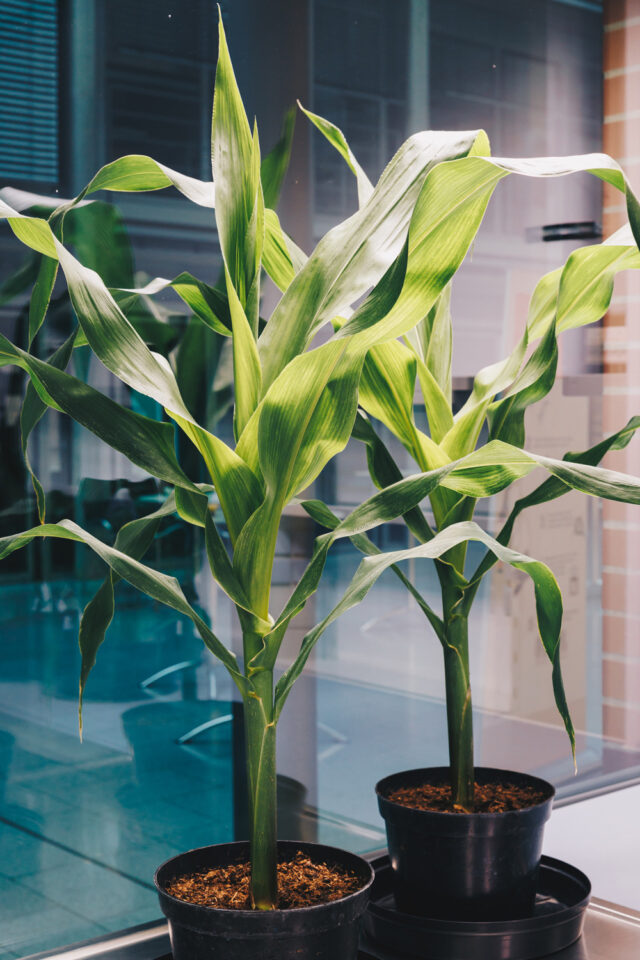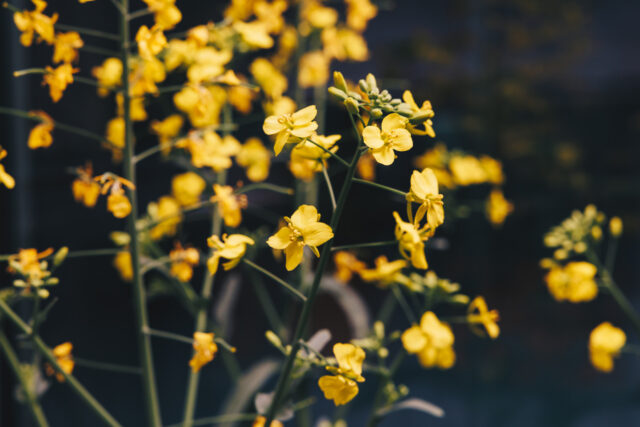Hannah Bemm and Eva Gietl (from left) have added sunflower as their latest exhibit. Here in the picture it is still a conventionally bred specimen, but we are planning to breed genome-edited sunflowers soon.
Exhibiting
The potential of breeding innovation
The glass-walled exhibition at the Einbeck headquarters is a popular stop-over for diverse visitor groups. It displays the benefits and science behind genome editing via posters, videos and live plants.
The exhibition was originally set up in 2019 and has recently been updated with sunflower, the latest addition in our KWS genome editing portfolio.
As a cross-departmental effort, the exhibition is designed and coordinated by Hannah Bemm, Scientist at Biotic Stress Traits, and Eva Gietl, Manager at Regulatory Affairs, with support from Nora Wehner from R&D Communications, as well as the Corporate Communications team.
Why do we need an exhibition dedicated to genome editing?
Eva Gietl: Genome editing helps us achieve important breeding goals faster than traditional breeding methods. It has great potential in the development of disease-resistant, climate-resilient, and high-yielding crops. This is a major benefit to farmers and to society overall – and one of the main messages of the exhibition.


Hannah Bemm: “We will need the support of future generations to further advance these new and innovative plant breeding methods.”
We also want to correct some misconceptions on genome editing: It is often mistakenly considered to be synonymous with classical genetic engineering. Furthermore, we show that genome editing is versatile and comprises a range of different methods and approaches.
Hannah Bemm: This exhibition further helps us to position KWS as a supporter and advocate of genome editing. Having the future challenges in mind, we see genome editing as an integral part of the breeder’s toolbox for sustainable trait development and thus also a contribution to the Farm to Fork Strategy of the EU.
The exhibition is currently located at the BiT Plaza in Einbeck. Did you have a primary target audience in mind?
Eva Gietl: Everyone is welcome! But regarding specific target groups, decision-makers are certainly important. Here in the EU, genome edited plants are regulated under strict GMO legislation, which restricts their use in product development. It is important to inform about the benefits of genome editing, and clearly and transparently explain the science behind it.
It would be nice if more farmers could see the exhibition as well. They play a key role in the acceptance of the method – and we would like to show them everything we can achieve with genome editing.
Journalists, of course, are another important group. They can multiply the message by spreading the information on our behalf.
Hannah Bemm: Another target group is the younger generation. Understanding is key to acceptance, and we will need the support of future generations to further advance these new and innovative plant breeding methods.
We are often asked to keep the exhibition lights on at late hours, so we know that there are groups discussing genome editing and new breeding methods almost around the clock. We also receive positive feedback at times – which is a nice acknowledgement of our work.


Eva Gietl: “It is important to inform about the benefits of genome editing, and clearly and transparently explain the science behind it.”
With live plants, it must take a lot of maintenance work to keep up the exhibition.
Hannah Bemm: The plants in the enclosure are examples for the crops we currently work on using genome editing – they are themselves not genome edited plants. To make sure that these plants are in good shape, we have great support from our green-thumbed colleagues Tuomas Saleema and Katharina Grote. Other coordinative tasks around the exhibition are mainly in the hands of our colleague Marina Kreiner from the Trait Development.
There are big differences regarding maintenance; sugarbeet can stay pretty and verdurous for weeks, whereas canola needs to be replaced frequently due to its short flowering period. We have to be attentive with respect to phytosanitary precautions, as, for example, aphids can spread rapidly. In the worst case this might result in a short-term closure of the exhibition with the need to replace all plants.
What are the next steps for the exhibition – do you have expansion plans?
Eva Gietl: There are changes expected in the EU regulatory landscape in the near future. This would change the whole idea of the exhibition, and what we can do with genome editing here at KWS, quite a lot.
Hannah Bemm: We just added sunflower to the exhibition, as the KWS crop portfolio of genome editing was expanded. Similar updates and expansions will certainly be taken over – the area of genome editing is developing fast, and our KWS genome editing group in St. Louis, Missouri, in the U.S., and colleagues here in Einbeck are making fast progress with exciting developments. Our latest addition is a digital poster, which allows us to display animations or even daily news. We are currently evaluating the option of transferring parts of the exhibition to a virtual format. |
This article is from insideKWS, the employee magazine of KWS. If you are an employee of our company, you have access to all other articles and previous issues. |
© KWS SAAT SE & Co. KGaA 2024
